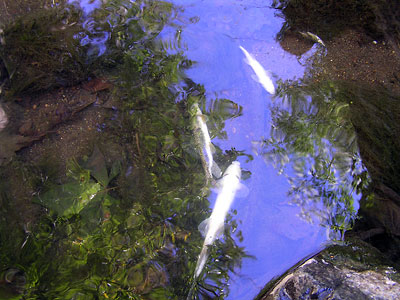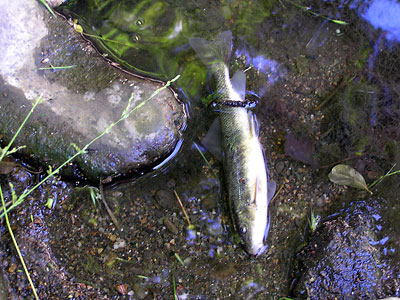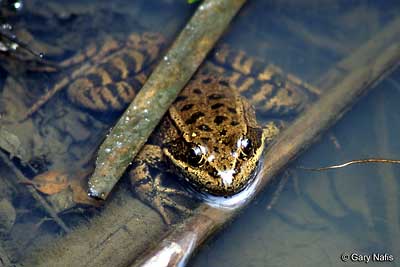
San Francisco Bay Area, California 408 227-5767
Chloramine Fish Kill From Water Main Break, Strawberry Creek, Berkeley, CA


Sacramento Sucker Catostomus occidentalis (from Urban Creeks Council)
Utility fined for spilling chemicals into Polhemus Creek, killing steelhead trout. May 31, 2009. Julia Scott, San Mateo County Times.
Water-main breaks proving deadly to fish. July 15, 2006.
Patrick Hoge, San Francisco Chronicle
- HTML: http://www.insidebayarea.com/sanmateocountytimes/localnews/ci_12491133
- View as a pdf on this website
Water-main breaks proving deadly to fish. July 15, 2006.
Patrick Hoge, San Francisco Chronicle

Chloramine used as a disinfectant in the water supply is fatal to frogs, including the California red-legged frog (Rana draytonii) in the photo above, classified as "threatened" by the U.S. Fish & Wildlife Service. Photograph of adult frog, San Mateo County, by Gary Nafis, http://californiaherps.com/frogs/pages/r.a.draytonii.html.
- January 31, 2005, Dead fish, Clark Dunson, Palo Alto Daily News
- April 12, 2006, Fish in pond died as result of chloramine, Marty McGrath, Sunnyvale Sun
- August 24, 2005, Water, Linda Corwin, Pacifica Tribune
Palo Alto Daily News
Monday, Jan. 31, 2005
Dead fish
Dear Editor: I recently moved to San Mateo from Palo Alto, where I cultured a fine family of aquatic life for seven years. When I changed the water here, they all died. I was devastated. It took about 20 minutes for all 80 fish, crawfish, and frogs to be wiped out. Twenty minutes! The fish store said "chloramines." So I restocked. I can change the water safely now, but only by treating it first (major hassle). But the frogs die no matter what I do.
There is a message here - like a canary in a coal mine - that we'd best heed. Frogs have long been known to be the bellwether of toxins. Industrial chemical companies carry a lot of clout, and seemingly would poison their own in their rationalizations for profit. Only we can provide the feedback that can stop such reckless chemical profiteering. Please join this fight, and help save our water and our health.
Clark Dunson,
Laurel Street,
San Mateo
Sunnyvale Sun
April 12, 2006
Fish in pond died as result of chloramine
Thanks for your March 29 article about the health concerns of chloramine in our water supply. I first became aware of the new additive after all my fish died. They were in an outside pond, so I replaced them and treated the water. They died again when the lawn sprinklers added enough untreated water to poison them again.
I didn't like the idea that water that comes out of the garden hose kills fish and frogs, so I looked into the situation further.
I found that my concerns were minor compared to the health problems other people were experiencing. I was further surprised that no significant health studies had been done before putting chloramine in our drinking water.
I think we all need to support Assemblyman Ira Ruskin's AB2402 to demand further testing of chloramine and looking at alternative disinfectants.
Now that I have become aware of the health issues caused by chloramine in our water, I believe that thousands are suffering, and they and their doctors have just not associated their problems to the water, which they bathe in and drink. Interested persons can contact Citizens Concerned About Chloramine to learn more.
Marty McGrath
Sunnyvale
Pacifica Tribune
August 24, 2005
Water
Editor:
When reading a letter in last week's Tribune, I noticed an interesting coincidence. The writer mentioned that the pier was being washed from one end to the other, then he mentions that the salmon fishing has been slow this year.
A report done by the Canadian EPA and published in 2001, says that salmonids can detect and will avoid water with levels of chloramine as low as 0.05 mg per liter. The water used to wash the pier has a concentration of about 2.2 mg per liter. So, I'm wondering if a clean pier equals fewer salmon. I encourage anyone who is interested in the correlation between chloramine and the deaths of marine organisms to log onto ESB.DSE@ec.gc.ca to obtain the "Assessment Report - Inorganic Chloramine." This report also says that freshwater organisms will suffer at chloramine concentrations above 0.0056mg per liter and marine organisms will suffer at chloramine concentrations above 0.0028 mg per liter. It was from this data that Canadian EPA determined that chloramine was toxic.
Linda Corwin
Sharp Park
Environment Canada
Existing Substances Evaluation
Assessment Report - Inorganic Chloramine
Santa Clara County Vector Control District, Department of Environmental Health
Chloramines and Mosquito Fish
Existing Substances Evaluation
Assessment Report - Inorganic Chloramine
- PDF: http://www.ec.gc.ca/substances/ ese/eng/psap/final/chloramines.cfm
- PDF on this website: Assessment_Report_Inorganic_Chloramine.pdf (83 KB)
Santa Clara County Vector Control District, Department of Environmental Health
Chloramines and Mosquito Fish
- PDF on this website: scc_chloramine_mosquito_fish.pdf (125 KB)